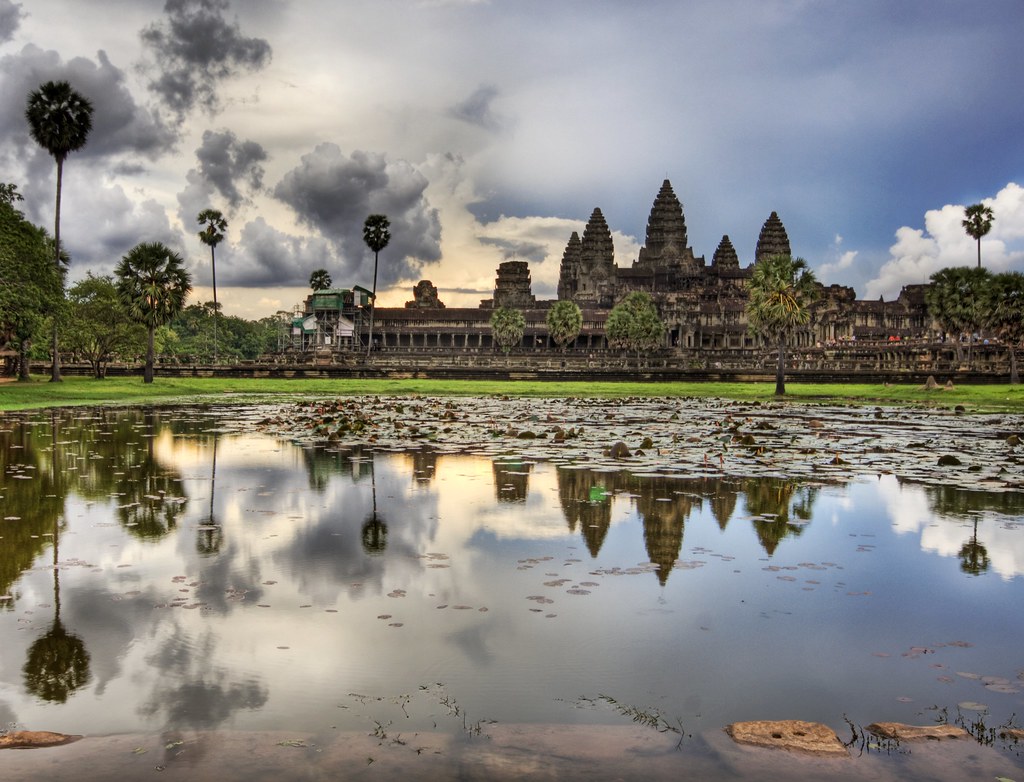Two letters down and now only twenty four to go! For C, our journey has led us on a 773 mile trek (essentially a round trip drive from San Francisco to LA) through thick jungle and rainforest to one of Burma's neighbors, Cambodia. Like Burma, Cambodia is centrally located in Southeast Asia, bordering Thailand to the west, Laos to the northeast, and Vietman to the east. The country is large, but relatively small when compared to Burma, which has a population 4x the size of Cambodia (Cambodia has around 15 million people).

Cambodian culture and cuisine (also referred to as Khmer cuisine) was influenced dramatically by the largest neighbor in the region, India. Indian art, culture, and language first made an appearance in Cambodia during the 1st century A.D. For many years, Cambodia's strategic location near the Pacific and the Gulf of Thailand made it an important pitstop for Pacific trading between India and China and as a result Cambodia absorbed a lot from its neighbors. Cambodian culture took in not only Indian influences (tumeric and ginger), but also those of China (stir fries, rice noodles, soy sauces), Thailand (galangal roots, kaffir limes, curries, fish sauces), and influences from other neighboring countries such as Laos, Vietnam, and Indonesia. Similar to Thai cuisine, Cambodian meals are comprised of four basic elements: sweet, sour, salty, or bitter. What's interesting though is that unlike Thai cuisine, an element that's visibly missing in Cambodian food is the "heat" (you know that crazy spicyness that leaves your lips burning, your eyes boiling, your cheeks red, and your forehead sweating up a fiery storm). The heat/chili part is usually something that's served on the side during meal time vs. something that's infused in the dish. This is why you usually don't see spicy dish warnings (you know that spicy chili pepper symbol next to the food item on the menu) at Cambodian eateries. There are always exceptions, of course!

Angkor Mat (photo courtesy of this site)
Now to the restaurant. Unlike Burma Superstar, Angkor Borei did take reservations and there was no waitlist. In fact, the restaurant was the complete reverse of what we experienced at Burma Superstar, where the venue was loud, trendy, and somewhat frenzied. This restaurant was pretty low key (granted it was a Monday night) and contrary to Burma Superstar our expectations were not very high. The food though turned out to be pretty damn good. Angkor Borei is located in Bernal Heights (really more like the outskirts of the Mission) and derives its name from the golden age of Cambodian history (the Angkor period between the 9th and 14th centuries), where Cambodia was a prosperous and powerful empire that dominated much of inland Southeast Asia. Angkor is also the conventional name for the region that held the seat for the Khmer rulers during this time period. At one point Angkor housed over 100 majestic temples (the most famous is the temple of Angkor Wat - considered to be the world's largest single religious monument). Today, much of the great capital lies in ruins from ravenous wars of the past. Much of Angkor now remains hidden beneath rain forest canopies and the Cambodian landscape. Interesting note: Recently (in 2007), researchers declared Angkor to be the largest pre-industrial city in the world (the Mayan city of Tikal is now considered the second largest).

Fresh Spinach Leaves
 Cambodian Crepe
Cambodian CrepeLet's talk food. The food at the restaurant was actually quite yummy. After much deliberation, we finally settled on our appetizers. The dishes we ordered to start included a beef salad (pretty decent, but needed to be a little bit spicier. This dish included spearmint, bean sprouts, cucumber, scallions, peppers, carrots, and lime juice), squid salad (not for the squeemish, but highly praised and offered a great blend of spices), fresh spinach leaves (a simple, tasty, finger food dish. It's served on a large plate with spinach leaves at the center and small serving bowls around it. Each bowl is filled with a unique ingrediant including ginger, peanuts, lime wedges, red onion, chili, dried shrimp, toasted cocunut, and a special Angkor Borei dipping sauce. You essentially make a small, healthy taco out of it), and crispy cambodian crepes (filled with tofu and served with ground peanuts and a lemon-garlic sauce).
Now the entrees. Our indecisiveness led to a lot of waiter based recommendations, but combined with the few dishes we wanted to order, we had an arsenal of delectable plates meticulously chosen to satisfy our varied palates. Our choices for the night were: Pineapple Fried Rice (this dish by far wins the top prize for showiest presentation. The rice goodies were stuffed inside a whole pineapple shell!), Clay Pot Mock Duck (vegeterian dish simmered with a lot of veggies and spices), Clay Pot Shrimp (shrimp dish with lemongrass, sweet basil, shallots, and a spicy garlic-lime sauce. The sauce here is key. Without it the shrimp were honestly pretty bland), Ahmonk (mild red curry fish mousse wrapped in a banana leaf basket), Spicy Green Tofu Curry (a very traditional curry dish, although it lacked the heat commonly found in comparable Thai dishes), and Pumpkin Curry (we ordered a tofu and chicken version. This dish was beautifully served atop an edible pumpkin half. Very creamy and rich in taste, similar to what we had ordered at the Afghan restaurant). The most popular dish of the night had to be the pumpkin curry as it left everyone in the group giddy with satisfied and stuffed smiles.
 Pumpkin Curry
Pumpkin Curry

No comments:
Post a Comment